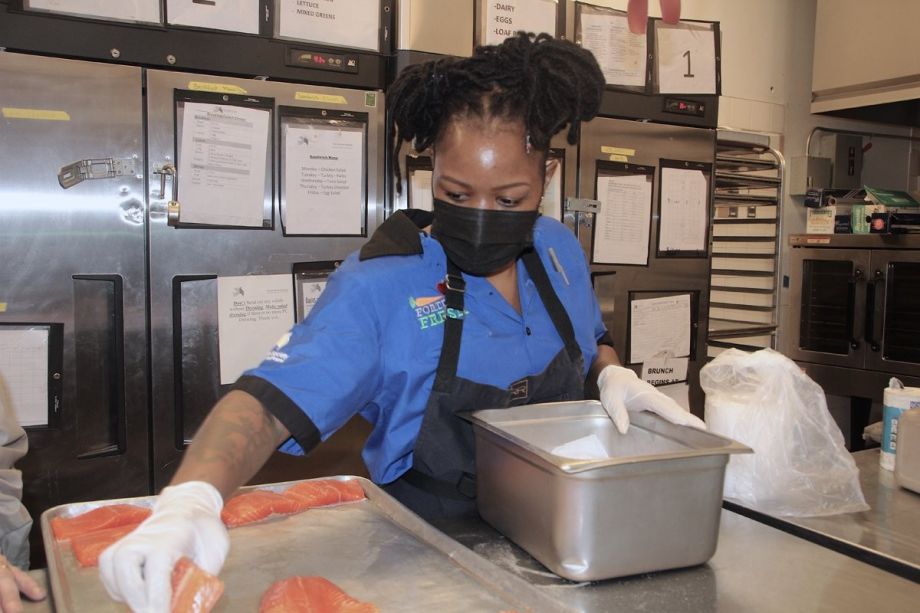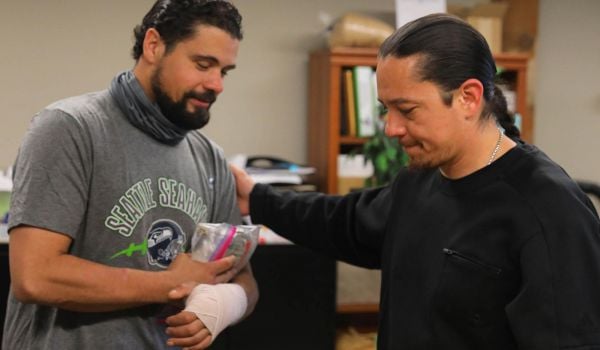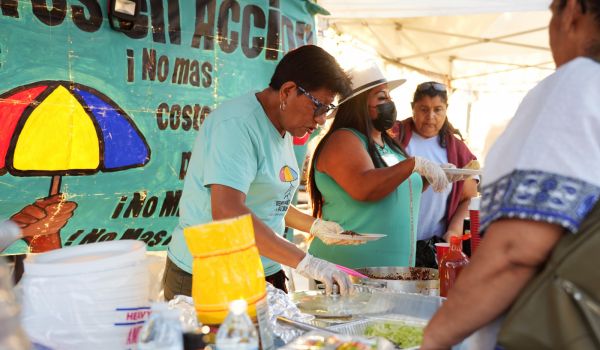When Stanley Richards was released from a New York State prison in 1991, the only way he knew how to feed himself was with the fried Jack Mack he’d eaten during his four-and-a-half years behind bars for a robbery conviction. This classic cell-cooked dish, named for the cheap canned jack mackerel that inmates receive in care packages from home or purchase in the commissary, had been far preferable to both the food and the vibe in the prison’s mess hall.
Notoriously devoid of fresh vegetables and frills, institutional prison food—which in New York State is mass produced outside the small city of Rome for less than $3 per inmate per day—is heaped onto a “hard tray, and you might not be able to finish it because they only give you three to five minutes to eat, then the guards knock on the table and you gotta empty your tray,” Richards said.
Thirty years later, Richards is executive vice president of the Fortune Society, a nonprofit that since 1967 has offered reentry support to about 9,000 men and women a year in three locations in Queens and Manhattan, as well as on-site at jails. The organization offers formerly incarcerated people help finding housing, counseling, employment training, and other wraparound services.
As he works to expand his own cooking repertoire, Richards has become ever more aware of the value of “using food to build community.” At Fortune, he said, “we have an opportunity to provide nourishing and healthy food. But when we break bread together, we can also laugh, socialize, bond, communicate, and heal.”
Expanding the Menu
When Richards first started working as a counselor at Fortune two months into his parole, its residential facility in upper Manhattan, called the Castle, hadn’t yet opened. That happened more than a decade later in 2002, and its kitchen began churning out hot meals soon after. From there, inspired by “Black families on Sundays that gather around,” he said, Fortune began to steadily develop a well-rounded food and nutrition program that sought to address the power and relevance of a good meal for people who’d been involved in the justice system.
Even today, ample fixings for peanut butter and jelly sandwiches are always on offer in the kitchen at the Castle, which provides emergency and transitional housing for 60 men and women for an average of 12 to 13 months, until they’re ready to move into their own apartments or in with their families. The PB&J is a way to address not only hunger, but also hoarding tendencies and other food anxieties that formerly incarcerated folks often experience. “You don’t go to prison for 20 or 30 years and come out fresh, squeaky-clean healthy in all ways,” said Jaime McBeth, who joined Fortune in 2014 and now serves as director of food and nutrition—an unusual position within reentry programs. “There’s a lot of trauma involved.”
By then, the organization’s Queens location had already been serving tuna sandwiches and hot dogs for lunch to day clients accessing training, services, and counseling. But when Fortune surveyed its clients, it learned that many of them lived in areas with poor access to healthy food and might not otherwise eat on a given day. “We said, we have to do something if this is their only meal,” Richards said. “We have to make sure it’s hot and nutritious.”
When McBeth was hired, she started devising new menus for the Queens location and the Castle; she coordinated with a distributor that worked with local farms to bring in fresh, high-quality produce and proteins. And yet the cost per meal at the Castle is comparable to mass-produced prison meals. On a recent weekday, for instance, some of the Castle staff were oohing and aahing over the glistening, bright orange fillets of steelhead trout McBeth had recently procured.
McBeth hired two chefs, one for each Fortune kitchen, and started a nutrition-counseling program. To deal with potential pushback against less familiar meals, she also expanded attendance of weekly cooking demos—by a third chef—from 20 to 200 to familiarize Fortune clients with new-to-them healthy dishes. “You don’t have stuff like salads and garlic spinach in prison, and with the demos they can go from ‘I don’t want to try that’ to ‘I want more,’” Richards said.
The Value of a Hot, Nutritious Meal
“Iam a dietician, and that means I want to make sure that our food is well-balanced and nutritious—that’s our foundation,” McBeth said. “From there, we want to make sure [clients] eat it, that it tastes good, and that we don’t go too far in terms of it being unfamiliar.” In coordination with Nicole Gurley, the Castle’s chef of four years, she devises menus for every day’s breakfast, lunch, and dinner that riff on what she calls “traditional” foods: burgers and yucca fries and arroz con pollo.
“We’ve got a few Caribbean people in the building, so we’ll do Rasta pasta [with Jamaican jerk spices] and basic Southern African American foods like greens and yams and chicken,” McBeth said. All of this is meant to override memories of “very starchy meals that fill you up.” To figure out what may or may not be popular, she checks the trash to see what got tossed.
Chef Nikki (pictured at top), as Gurley is known around Fortune, normally has two jobs—one at the Castle and one as chef de partie at the Rainbow Room, Rockefeller Center’s landmark restaurant, which has been shut down this year due to the pandemic; she’s been working full-time at the Castle since June 2020. Gurley also has first-hand experience with feeling undernourished by food, which made her especially eager to serve this group in a way that “gives you a little dignity with the meal,” she said.
Gurley grew up in Newark, New Jersey, where, she says, “everyone around me was on drugs.” She dropped out of school in the eighth grade, ran the streets, then spent a year in a youth house. Even after she began apprenticing at a kosher butcher—before working her way up in fast casual then small mom-and-pop restaurant kitchens—she she still found herself hungry at times. “I could eat at work but then on a day off I’m broke because the rent is so high. Then you go to soup kitchens and it be like a soup broth with a few pieces in it, or Dunkin’ Donuts” but it’s stale, she said. “Just because you find yourself in a tough situation, that doesn’t mean you have to have crap for food.”
She and McBeth usually sit down to plot out meals a week or even a month in advance, which allows them to plan around including local, seasonal ingredients. Her recent dinners have included oven-fried chicken and black-eyed peas, and steak in mushroom-shallot gravy with garlic peas and sweet potato fingerlings. They’re designed to be balanced, but they always reflect the fact that many Castle residents are older, with bad teeth, and potentially obsessive about their health.
“It surprised me coming here how these guys really, really care about their nutrition,” Gurley said. “They don’t want things with salt in it. They want vegetables. ‘How come we not getting a salad today?’ [they ask]. You’d think they’d just happy to get a meal, but no, they want real food just like anybody. Eating junk all day—that doesn’t make you feel good.”
Some people switch to kosher or halal diets to access special meals when they go to prison, as a way to maintain some semblance of control over their lives, and many retain those habits once they’re out. “In an institution, they tell you when it’s lights out and lights on, when to get out of your cell, when to stand for count, when you can go eat, when you can go to recreation,” Richards said. “The only thing you can control is yourself.”
One fan of Gurley’s cooking is Raymond Cruz, who was released from Rikers Island 10 months ago and has been living at the Castle ever since; he also works around the kitchen, scrubbing pots, sweeping, and helping pack up meals to deliver to rooms now that COVID has shut down communal dining. At Rikers, “you cook your own crackhead soup”—another prison staple that relies on live-wiring a cup of water to cook noodles—“because the food there is terrible,” Cruz said. “Everything is cold, and maybe you get a slice of lettuce and no fresh fruit.” At the Castle, though, “everything Chef Nikki cooks is good. It’s fresh, and I can laugh with [everyone here] and they treat you like real family. In jail you can’t do that. Being here gives you a lot of hope.”
Communal meals have been “sorely missed,” Richards said. Sit-down holiday meals, where staff at the Castle serve residents and their families, as well as an annual food-centric block party that’s held to help estranged families start to build back relationships, were all canceled this year. Weekly community meetings at the Castle have switched to Zoom, and Queens’ day clients receive to-go bags that include lunch and some food staples to tide them over for a few days.
“But it doesn’t replace the warmth that sitting down and having a conversation and community can bring,” Richards said. “There’s no replacing that.”
This story originally appeared in Civil Eats and appears here as part of the SoJo Exchange from the Solutions Journalism Network, a nonprofit organization dedicated to rigorous reporting about responses to social problems.
Lela Nargi is a veteran journalist covering food policy and agriculture, sustainability, and science for outlets such as The Guardian, The Counter, City Monitor, JSTOR Daily, Sierra, Civil Eats and Ensia. She’s also the author of science books for kids. Find her at lelanargi.com and @LelaNargi.






_600_350_80_s_c1.jpeg)









